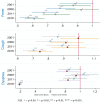Trends in the prevalence and care-seeking behaviour for acute respiratory infections among Ugandan infants
- PMID: 30976661
- PMCID: PMC6440134
- DOI: 10.1186/s41256-019-0100-8
Trends in the prevalence and care-seeking behaviour for acute respiratory infections among Ugandan infants
Abstract
Background: Acute Respiratory Infections (ARIs) as a group of diseases/symptoms constitute a leading cause of pediatric morbidity and mortality in sub-Saharan Africa where over 10 % of all children die before reaching their fifth birthday. Although the burden of ARIs is highest in the African countries, there is little evidence in the current literature regarding their prevalence and treatment seeking. The objective of this study was therefore to assess the secular trend in the prevalence of ARIs as well as their treatment seeking-behaviour among Ugandan infants.
Methods: This cross-sectional study was based on data from Uganda Demographic and Health Surveys (conducted between 1995 and 2016) on 26,974 singleton infants aged 0-5 months. Mothers (aged 15-49 years) were interviewed to collect information on the prevalence of recent occurrences of fever, cough and dyspnea. The adjusted trend in the prevalence and predictors of ARIs and care seeking were measured by multivariate regression methods.
Results: In 2016, the prevalence of fever, cough and dyspnea was respectively 36.23, 42.55 and 19.27%. The prevalence of all three symptoms has been declining steadily since 1995, and the percentage of children receiving treatment for fever/cough has also more than doubled during the same time. In multivariable analysis, several sociodemographic factors emerged as significant predictors of ARIs including child's age and high birth order, mother's age, educational level, occupation, intendedness status of the child, BMI, household wealth status, and place of residency.
Conclusions: The overall prevalence common ARIs (fever, cough, dyspnea) has been declining at a slow but steady rate, however, remains noticeably high in comparison with countries with similar level of per capita GDP in Africa. Findings of this study has important implications for health policy making regarding the prevention of ARIs among infants in the country.
Keywords: Acute respiratory infections; Care-seeking; Demographic and health survey; Global Health; Infant; Uganda.
Conflict of interest statement
Not applicable.Not applicable.The authors declare that they have no competing interests.
Figures




Similar articles
-
Burden of Acute Respiratory Infections Among Under-Five Children in Relation to Household Wealth and Socioeconomic Status in Bangladesh.Trop Med Infect Dis. 2019 Feb 12;4(1):36. doi: 10.3390/tropicalmed4010036. Trop Med Infect Dis. 2019. PMID: 30759811 Free PMC article.
-
Factors of acute respiratory infection among under-five children across sub-Saharan African countries using machine learning approaches.Sci Rep. 2024 Jul 9;14(1):15801. doi: 10.1038/s41598-024-65620-1. Sci Rep. 2024. PMID: 38982206 Free PMC article.
-
Factors influencing mothers' health care seeking behaviour for their children: evidence from 31 countries in sub-Saharan Africa.BMC Health Serv Res. 2020 Sep 7;20(1):842. doi: 10.1186/s12913-020-05683-8. BMC Health Serv Res. 2020. PMID: 32894107 Free PMC article.
-
Prevalence, determinants and health care-seeking behavior of childhood acute respiratory tract infections in Bangladesh.PLoS One. 2019 Jan 10;14(1):e0210433. doi: 10.1371/journal.pone.0210433. eCollection 2019. PLoS One. 2019. PMID: 30629689 Free PMC article.
-
The epidemiology of acute respiratory infections in children and adults: a global perspective.Epidemiol Rev. 1990;12:149-78. doi: 10.1093/oxfordjournals.epirev.a036050. Epidemiol Rev. 1990. PMID: 2286216 Review.
Cited by
-
Prediction of acute respiratory infections using machine learning techniques in Amhara Region, Ethiopia.Sci Rep. 2024 Nov 14;14(1):27968. doi: 10.1038/s41598-024-76847-3. Sci Rep. 2024. PMID: 39543232 Free PMC article.
-
Socioeconomic Determinants of Maternal HealthCare Utilisation in Zambia: 1997-2014.Inquiry. 2021 Jan-Dec;58:469580211067480. doi: 10.1177/00469580211067480. Inquiry. 2021. PMID: 34911372 Free PMC article.
-
Antenatal visits are positively associated with uptake of tetanus toxoid and intermittent preventive treatment in pregnancy in Ivory Coast.BMC Public Health. 2019 Nov 6;19(1):1467. doi: 10.1186/s12889-019-7847-1. BMC Public Health. 2019. PMID: 31694607 Free PMC article.
-
Factors associated with mother's healthcare-seeking behavior for symptoms of acute respiratory infection in under-five children in sub-Saharan Africa: a multilevel robust Poisson regression modelling.BMC Health Serv Res. 2023 Oct 5;23(1):1061. doi: 10.1186/s12913-023-10065-x. BMC Health Serv Res. 2023. PMID: 37794438 Free PMC article.
-
Barriers to healthcare access and healthcare seeking for childhood illnesses among childbearing women in sub-Saharan Africa: A multilevel modelling of Demographic and Health Surveys.PLoS One. 2021 Feb 8;16(2):e0244395. doi: 10.1371/journal.pone.0244395. eCollection 2021. PLoS One. 2021. PMID: 33556057 Free PMC article.
References
LinkOut - more resources
Full Text Sources

